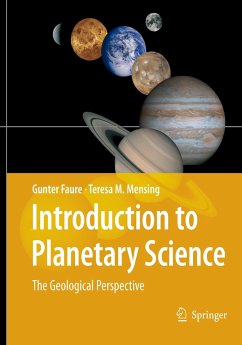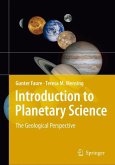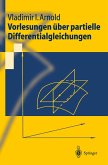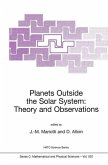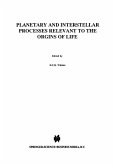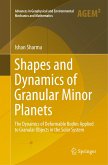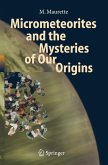This textbook is intended to be used in a lecture course for college students majoring in Earth Sciences. Planetary science provides an opportunity for these students to apply a wide range of subject matter pertaining to the Earth to the study of other planets and their principal satellites. In this way, planetary science tends to unify subjects in the Earth Sciences that are traditionally taught separately. Therefore, planetary science is well-suited to be taught as a capstone course for senior undergraduates in geology departments and as an introduction to the solar system in astronomy departments. Both groups of students will benefit because planetary science bridges the gap between geology and astronomy and it prepares geologists and astronomers to participate actively in the on-going exploration of the solar system.
The subject matter is presented in 24 chapters that lead the reader through the solar system starting with historical perspectives on space exploration and the development of the scientific method. The presentations concerning the planets and their satellites emphasize that their origin and subsequent evolution can be explained by applications of certain basic principles of physics, chemistry, and celestial mechanics and that the surface features of the solid bodies in the solar system can be interpreted by means of the principles of geology.
The subject matter is presented in 24 chapters that lead the reader through the solar system starting with historical perspectives on space exploration and the development of the scientific method. The presentations concerning the planets and their satellites emphasize that their origin and subsequent evolution can be explained by applications of certain basic principles of physics, chemistry, and celestial mechanics and that the surface features of the solid bodies in the solar system can be interpreted by means of the principles of geology.
From the reviews:
"The authors ... have produced a book that is remarkably up to date, nicely illustrated, and written in an engaging style. An especially effective touch us that each chapter ends with one or more scientific briefs ... . presents an abundance of fascinating information about our cosmic neighborhood, in a form that is readily accessible to students majoring in Earth science. This text will significantly improve teaching and learning about planetary geoscience, and I will be using it for my own undergraduate course ... ."
(Hap McSween, Elements, Vol. 4 (1), 2008)
"This book should be used as the basis for a capstone course for senior undergraduates and beginning graduate students majoring in the Earth sciences. ... The book is fairly well up to date in terms of discoveries ... . Positive points about the book include clear and abundant illustrations and a well-chosen reference list at the end of each chapter. ... well-bound and well-illustrated book. ... is comprehensive and balanced in its coverage of bodies in the solar system."
(David A. Rothery, Eos, Vol. 89 (15), 2008)
"When I was asked to review this textbook, I immediately said yes. I expected that I would enjoy reading the book and that I would undoubtedly learn from it either new facts or methods of presenting facts and their interpretation to students. I was not disappointed; in fact, I was delighted. The book captures the essence of modern planetary science in 24 chapters. The chapters do not overload the reader with an abundance of factual details and their interpreatations but instead present issues at a level that can be clearly understood by majors and nonmajors alike but without compromising the science. The book is clearly excellent - if not outstanding - for use in a course for nonmajors, and I highly recommend it. ... The book is not organized in what I consider to be a classic approach, which is actually a delightful change,and it works very well. In addition, the "science briefs" at the ends of chapters are a wonderful affirmation of each theme. Overall, the book is excellent."
(Harold C. Connolly Jr, The Journal of Geology, Vol. 116, p. 313, 2008)
"Introduction to Planetary Sciences - the Geological Perspective ... is the brain-child of Gunter Faure and Theresa M. Mensing. ... this text not only helps me to acquire new teaching material for my lecture classes, but also exposes me to the latest cosmologic discoveries, told from a geologic point of view. ... . It is the authors' unique ability to intertwine a strong dose of geology, with planetary science, in an easy to understand presentation, that generates the appeal of this book."
(Joseph F. Born Jr., American Association of Petroleum Geologists, Vol. 92 (5), May, 2008)
"A fascinating look at the worlds of our Solar System.
In this excellent textbook, Faure and Mensing succinctly and clearly describe what our Solar System is made of and how it works. Each planet is described in detail-its geology, history, satellites, chemistry, and orbital mechanics. The latest planetary knowledge is presented, and the book is very up-to-date on the latest developments in planetary science, with plenty of new information gleaned from the Hubble Space Telescope and the Cassini Probe. Principles of physics, chemistry, and geology as they pertain to the planets and their celestial mechanics are presented and every chapter is very well-written, clear, and fascinating.
The excellent text is complemented by many brilliant and fascinating pictures in every chapter, including new pictures of the surface of Titan from the Cassini Probe. The high quality of the pictures was a major factor which induced me to buy this book!
I would recommend this as a textbook for a geology class, and for anyone at all who has at least a basic background in science and wants to know more about theother worlds in our solar system and how they operate. It's not a cheap book but it's worth every penny."
(Gordon Trunk, Minneapolis, MN, USA, December 11, 2008)
"This book is a comprehensive review of the current knowledge of planetary sciences. ... The book is best suited for upper division undergraduate students and for beginning graduate students. ... a reference book on planetary sciences that will serve well the shelves of all Earth scientists. ... Due to its holistic and complete approach of the Universe and the Earth's place within the Universe, this book will benefit not only people involved in the planetary sciences but also all those involved in Earth Sciences." (Susana Custódio, Pure and Applied Geophysics, Vol. 166, 2009)
"The authors ... have produced a book that is remarkably up to date, nicely illustrated, and written in an engaging style. An especially effective touch us that each chapter ends with one or more scientific briefs ... . presents an abundance of fascinating information about our cosmic neighborhood, in a form that is readily accessible to students majoring in Earth science. This text will significantly improve teaching and learning about planetary geoscience, and I will be using it for my own undergraduate course ... ."
(Hap McSween, Elements, Vol. 4 (1), 2008)
"This book should be used as the basis for a capstone course for senior undergraduates and beginning graduate students majoring in the Earth sciences. ... The book is fairly well up to date in terms of discoveries ... . Positive points about the book include clear and abundant illustrations and a well-chosen reference list at the end of each chapter. ... well-bound and well-illustrated book. ... is comprehensive and balanced in its coverage of bodies in the solar system."
(David A. Rothery, Eos, Vol. 89 (15), 2008)
"When I was asked to review this textbook, I immediately said yes. I expected that I would enjoy reading the book and that I would undoubtedly learn from it either new facts or methods of presenting facts and their interpretation to students. I was not disappointed; in fact, I was delighted. The book captures the essence of modern planetary science in 24 chapters. The chapters do not overload the reader with an abundance of factual details and their interpreatations but instead present issues at a level that can be clearly understood by majors and nonmajors alike but without compromising the science. The book is clearly excellent - if not outstanding - for use in a course for nonmajors, and I highly recommend it. ... The book is not organized in what I consider to be a classic approach, which is actually a delightful change,and it works very well. In addition, the "science briefs" at the ends of chapters are a wonderful affirmation of each theme. Overall, the book is excellent."
(Harold C. Connolly Jr, The Journal of Geology, Vol. 116, p. 313, 2008)
"Introduction to Planetary Sciences - the Geological Perspective ... is the brain-child of Gunter Faure and Theresa M. Mensing. ... this text not only helps me to acquire new teaching material for my lecture classes, but also exposes me to the latest cosmologic discoveries, told from a geologic point of view. ... . It is the authors' unique ability to intertwine a strong dose of geology, with planetary science, in an easy to understand presentation, that generates the appeal of this book."
(Joseph F. Born Jr., American Association of Petroleum Geologists, Vol. 92 (5), May, 2008)
"A fascinating look at the worlds of our Solar System.
In this excellent textbook, Faure and Mensing succinctly and clearly describe what our Solar System is made of and how it works. Each planet is described in detail-its geology, history, satellites, chemistry, and orbital mechanics. The latest planetary knowledge is presented, and the book is very up-to-date on the latest developments in planetary science, with plenty of new information gleaned from the Hubble Space Telescope and the Cassini Probe. Principles of physics, chemistry, and geology as they pertain to the planets and their celestial mechanics are presented and every chapter is very well-written, clear, and fascinating.
The excellent text is complemented by many brilliant and fascinating pictures in every chapter, including new pictures of the surface of Titan from the Cassini Probe. The high quality of the pictures was a major factor which induced me to buy this book!
I would recommend this as a textbook for a geology class, and for anyone at all who has at least a basic background in science and wants to know more about theother worlds in our solar system and how they operate. It's not a cheap book but it's worth every penny."
(Gordon Trunk, Minneapolis, MN, USA, December 11, 2008)
"This book is a comprehensive review of the current knowledge of planetary sciences. ... The book is best suited for upper division undergraduate students and for beginning graduate students. ... a reference book on planetary sciences that will serve well the shelves of all Earth scientists. ... Due to its holistic and complete approach of the Universe and the Earth's place within the Universe, this book will benefit not only people involved in the planetary sciences but also all those involved in Earth Sciences." (Susana Custódio, Pure and Applied Geophysics, Vol. 166, 2009)
"The authors, Gunter Faure and Teresa M. Mensing, have produced a book that is remarkably up to date, nicely illlustrated, and written in an engaging style. An especially effective touch is that each chapter ends with one or more scientific briefs, introducing students to especially interesting topics in greater detail."
"This text will significantly improve teaching and learning about planetary geoscience, and I will be using it for my own undergraduate course, supplemented with other readings."
H. McSween, in Elements, Vol. 4, Nr. 1, February 2008
"This text will significantly improve teaching and learning about planetary geoscience, and I will be using it for my own undergraduate course, supplemented with other readings."
H. McSween, in Elements, Vol. 4, Nr. 1, February 2008

